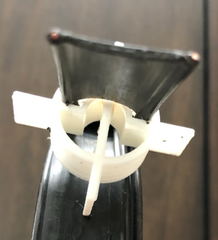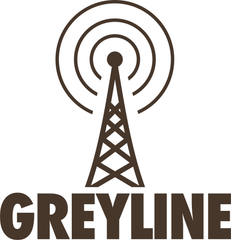Greyline DX Feedline Kit: Ladder-line to Coax PL-259 Adapter

Greyline DX Feed line Kit:
Ladder-line to Coax PL-259 Adapter
The Greyline DX Feedline Kit is designed to offer you another option to connecting your Coax to the antenna system.
Some say, "what's that?" when noticing a short roll of ladder line in the feed line kit. Yes, you can connect your coax to this feedline kit that is included with the antenna package.
In the old days we used coax inside the Antenna. This worked great over the years but was problematic for the higher power users. In comes a genius idea of using instead a few feet of ladder line within (internally) our feed system offering you the lowest losses and highest efficiency possible, again, where coax performance was surpassed. Just another little improvement in the life of Greyline Performance antenna systems.
Always remember, every single dB counts and we aim to delivery to your radio every little dB possible for your reception and of course on transmit, to your antenna, where it can be propagated most efficiently.
Keep in mind, we reserve the right to create even better options without notice. (You're welcome!)
The below picture is just a sample but please know that ALL shipments by default from Greyline will include a Feedline Kit. Note that the style(s) of these feedline kits do change based on which vendors we are using at the time. We do change vendors to share your buying power. Some may have different shaped PL-259 adapters, or RF Choke styles but they all do the same job, for you.

Note: The little white chassis is a 1:1 Adapter (Ladder-line to PL-259)
That's a ladder line to a coaxial connector converter that enables the ladder line to couple easily to a coax connector making connecting your antenna to the remote tuner, plug n play, just like most of us prefer. (soldering iron not needed). The adapter we ship in your Antenna package may or may not resemble the look but does the intended job for you.
Some automatic or manual HF tuners offer use of Balun posts or random wire terminals for antenna connections on the back chassis of an ATU, which are used to connect directly from the ladder line to the remote tuner. Other tuners offered on the market today do not offer these options, instead they present to you simply the SO-239 for your Coaxial connector to plug into, which makes more sense, right? So, even the purists amongst you will now enjoy having more options, as you wish. Both options work great.
These folks would tell us that fewer junctions are better, less lossy, less opportunity for failures, and therefore preserves precious dB's for your intended use, the output and reception of actual signals.
We combine the wisdom of these purist friends and make life easy for you so plug n play is a reality while preserving a very high quality experience for you as well. More signal, less headache.
In 2018, we chose to remove the more lossy coax stub here and replace it with Ladder line, or window line, in the feed line sections of the antenna system to take advantage of newly discovered performance (dB's), offering us all less loss and more DX. Even the high power guys can appreciate this one. Oh, and they do.
In order to make this simple for those less technically inclined, we developed (Thanks, W6NBC!) an adapter that allows the purists to choose ladder line and those of us QCAO (Quarter Century Appliance Operators Club types!) to choose the universally acceptable, Coax connector. The purists appreciate fewer adapters, even though our adapter is very low loss and can take high power, too. We aren't letting a little Boy Scout project scare us, right?
If you want to get a head start, these parts are easily available online or you can receive one with your Feedline Kit included in your Greyline DX Flagpole Antenna order.
SPACERS: One note here on the Ladder Line Spacers... Inside the flagpole from the ground level to the feed-point, you'll want to install by hand the four included plastic spacers.
These can be added after you install the Flagpole with ease, if you wish. Simply pull the flagpole apart at the ground level insulator and push the ladder line section up to the feedpoint insulator for proper attachment there by cutting away 3-4" of ladder line plastic so one wire can travel out and up, the other out and down to fasten to the respective dipole sections. This leaves you with approximately 2 feet of ladder line out the bottom slot meant to connect to your ATU or coax to the shack.
These are 3D printed and work well to keep the ladder line centered within the Flagpole Antenna, away from the side walls and essentially, straight with clean lines.
Be sure to park the spacer in an open ladder square about a foot apart as they travel within the flagpole tubing.

Pro Tip: Keep in mind when attaching your feedline wires at the feedpoint to be certain you mark the upper part of your vertical dipole and match it with the center conductor of your coax. This is the radiator and works better than radiating the lower shorter portion of your radiator. Makes sense, right?
450 Ohm Window Line to PL-259 Interface Block
Parts needed:
- 3D Block Adapter Kit (block, bolts, nuts)
- PL-259
- UG-175 mini-8
Some users may find their ATU offers direct "long wire" terminals allowing connecting to the terminal and the ATU ground. No extra adapters. The rest of us using most modern ATU's on the market will find we need to adapt the ladder line to the more commonly used PL-259. This adapter kit is included in the antenna package. Most use this method, yet there are various methods one can choose, of course.
Remember, we do not ground the antenna system while in use. This includes the antenna, remote tuner, and RF Choke. Always follow ARRL & FCC guidelines for Grounding your station as a rule.
This little 3D-printed adapter block (pictured) psychologically and conveniently overcomes any reluctance in bare wire connection points, by providing a sturdy direct interface between the 450 Ohm window line and the tuner’s SO-239 jack. See Figure 1.

Figure 1: PL-259 to 450 Ohm Window line interface.

PL-259 and UG-175 mini-8
Figure 2 shows the interface shell with one of its two identical halves removed, exposing the wires and the insulation of the window line trimmed and soldered directly to a PL-259 solder-type connector and UG-175 mini-8 adapter. Also seen is a short length of 4 or 5mm Teflon tubing that replaces the polyethylene window line insulation.
The Teflon tubing enables the assembly to tolerate high power. Also for higher power, PL-259 connectors with Teflon insulation are preferable.
Pro tip: Solder the wire into the tip of the PL 259 before sliding the Teflon tubing into place. It can get hot and melt the tubing. You're welcome.

 Figure 2: Image credit, a YL Ham from W7
Figure 2: Image credit, a YL Ham from W7
Assembly with half of the shell removed because of the shaped recess in the printed shell halves, seen at the left of Figure 3, the PL-259 and UG-175 adapter, when tightened create a very positive clamp to the shell. To the right, a raised portion in the printed block halves also very tightly clamps the window line.
Note: For accurate context in the above photo, the UG-175 "mini" should be opened a bit wider presenting enough width to offer space for the lip of the clam shells. Then, one can tighten the UG-175 into the PL-259 to clamp the clam shells in place.

Figure 3: A shell half showing recess for UG-175 adapter (left) plus a window-line compression box (right)
The holes in one shell half are drilled out to 9/64 inch as clearance for 6-32 screws. The holes in the other half are tapped for 6-32 threads. Four ½ inch pan-head stainless screws clamp the shell halves together. Provided.
Note: if weatherproofing is desired, the shell may be filled with RTV silicone adhesive during assembly.
Assembly
Figure 4 shows the prepared ends of the window line, with dimensions. Lightly solder-tin to the wire tips.

Figure 4: Window line trimming dimensions.
Note 5 mm Teflon tubing replacing the window line insulation.
The insulation on one side is completely removed and replaced with 2¼ inches of 4-5mm Teflon tubing. The tubing reaches up all the way into the PL-259 connector and permits the interface to operate at full power.
Insert the longer window-line wire with the Teflon tubing installed into the UG-175 adapter. Insert the Teflon-covered wire and the UG-175 adapter into the PL-259 connector. Screw in the adapter only a turn or two. The center wire should stick out of the PL-259 connector pin just a little. Do not solder it yet.
Next place the assembly in one half of the shell. Further, screw together the PL-259 connector and the UG-175 adapter until they clamp the edge of the shell. Adjust the bend of the wires in the shell for a good fit. Then install the other half of the shell. You may fill the shell with an RTV silicone sealant at this time if you desire. A sealant is, however, not essential and may be omitted if the block ever needs to be disassembled.
Next, grasp the back end of the PL-259 connector with pliers and snug it up against the shell. Finally solder the PL-259 tip, trimming the center wire if required.
Depending on where the tuner is mounted, the interface block may be screwed onto the tuner either straight on turned 90 degrees to allow the window line to be led away appropriately.
Whether you are a coax plug n play operator or enjoy a little technical adventure you have a couple of easy and fun options here with the Ladder line to Coax PL 259 adapter.
Ham Radio is fun again!
73 Greyline Performance
www.greylineperformance.com

- LIST OF BENEFITS for Greyline Performance Antennas
- Common Questions from Ham Radio Customers
- 16' DX Flagpole Antenna and SGC-237 remote tuner works 160-6M (install pictures) at KJ7CWQ
- 80M: WD4MIR works KL7 from Kentucky on 80M with a 16' HOA Flagpole
- VIDEO: Wow, the Verticals vs. Yagi signal comparison is revealing
- Beautiful Flagpole Antenna, regularly work DX (Africa, Europe, SA) with 60W on FT8 and CW at WJ8B
- "Happy XYL" in Pennsylvania: New Ham says "happy wife, quiet bands & loud signals! Going for my Extra."
- Do I really need a Tuner at the Base of my Greyline Flagpole Antenna and HF Vertical Antenna
- 28' HF Vertical Antenna in New Mexico reports "good reports about strong signals"
- 20' Flagpole Antenna, Bill in Florida one-calls XR0ZRC with 100W & runs the bands after 30-years off the air!
- 24' Flagpole Antenna: K7CWC Cliff in Washington (W7) is spotted around the World on his Greyline 24' DX Flagpole
- Greyline makes the Cover of CQ Magazine from Montenegro - September 2021
- Surf Ham Radio Waves with KL2A
- Blog: Ham Radio Adventure Stories
- My XYL Love the Greyline Flagpole Antenna
- For YLs: Ham Radio Love Connection
- Samantha forms a Womens Ham Radio Friendship Club
